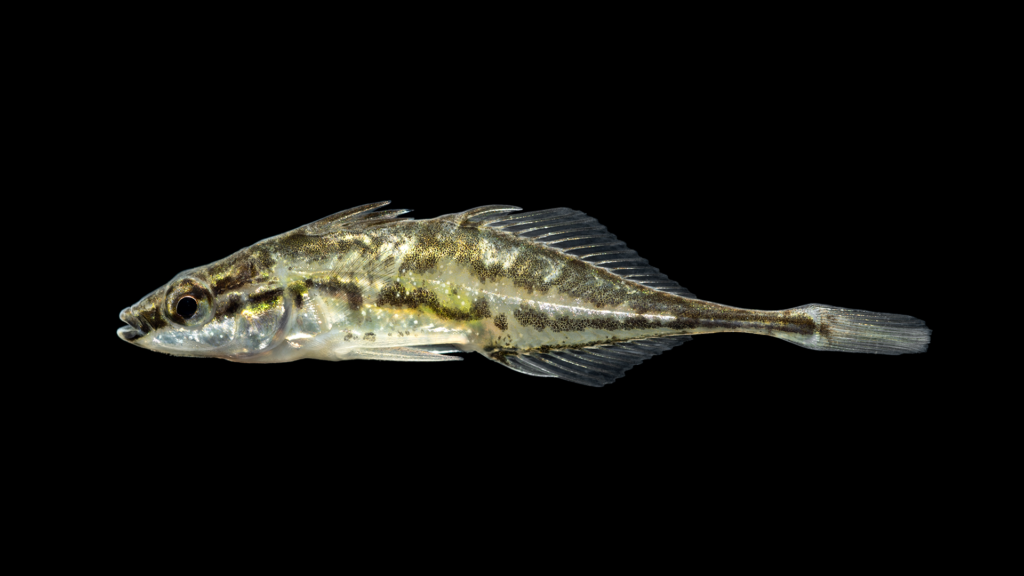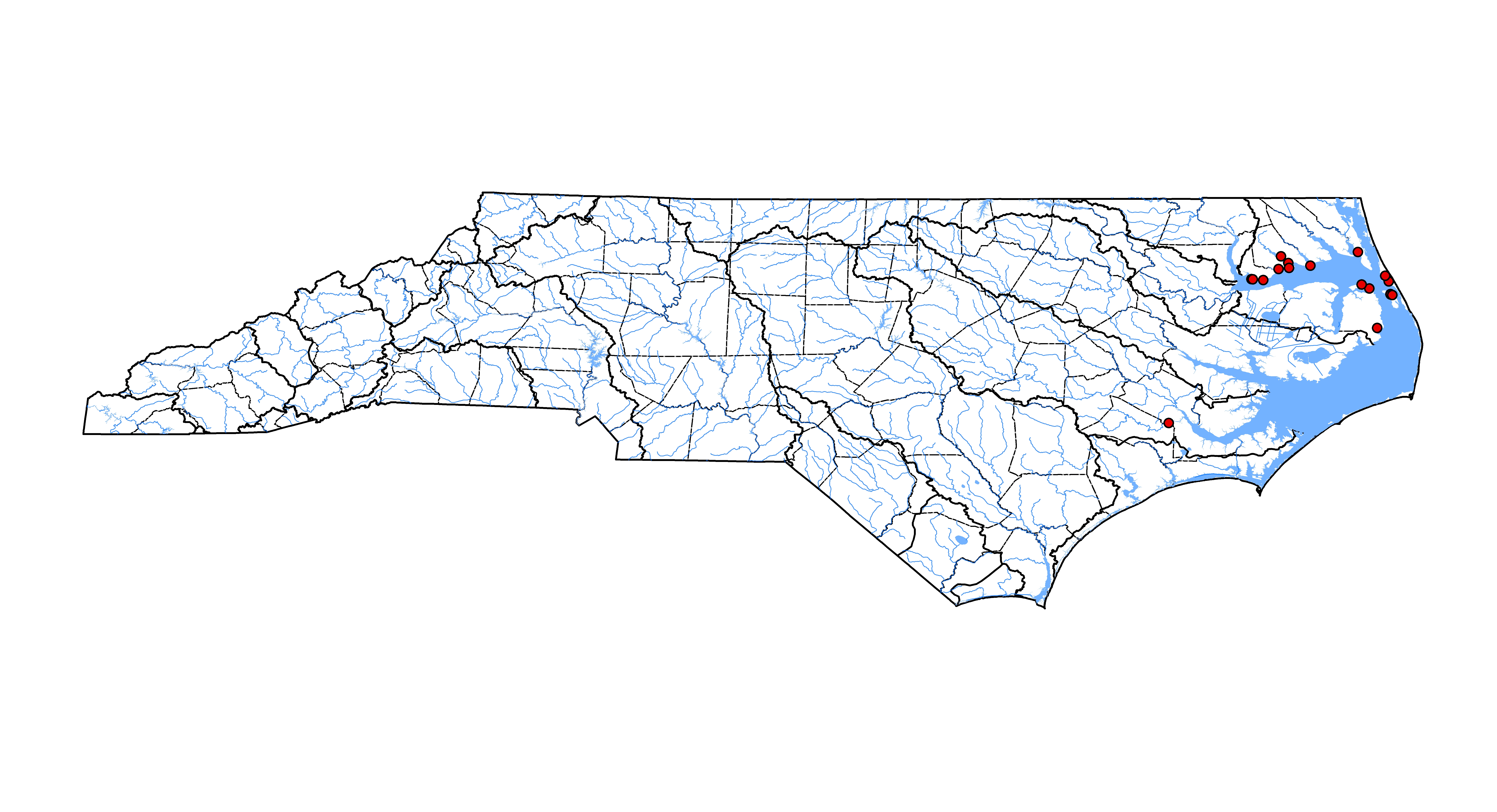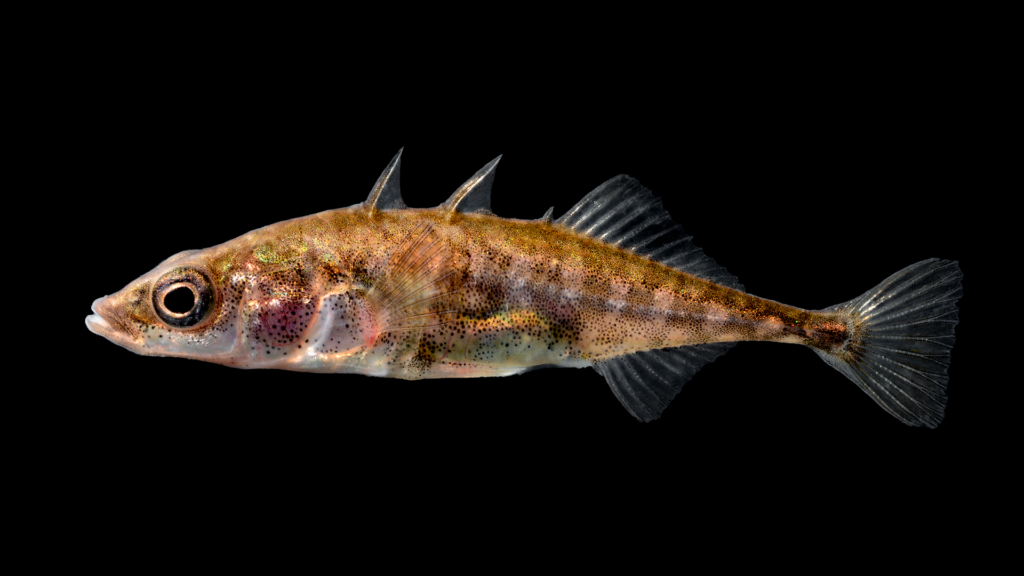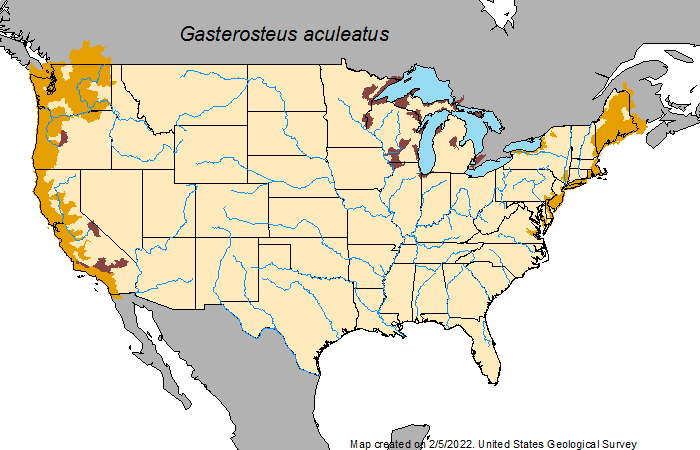By the NCFishes.comTeam
In eastern North America, the family Gasterosteidae, known as sticklebacks, is a small family of five species commonly found in shallow brackish inlets, calm, heavily vegetated marshes and estuaries, tidal creeks, lagoons, and in the nearshore and offshore open ocean (Kells and Carpenter 2014; Rohde et al. 1994). Along the Atlantic coast, sticklebacks are found from the Pamlico Sound north to the Gulf of St. Lawrence, Newfoundland, and Nova Scotia. The five species one is likely to encounter are: Fourspine Stickleback, Apeltes quadracus, Brook Stickleback, Culea inconstanus, Threespine Stickleback, Gasterosteus aculeatus, Blackspotted Stickleback, G. wheatlandi, and Ninespine Stickleback, Pungitius pungitius (Lee et al. 1980; Page and Burr 2011; Page et al. 2013).
All five species may be characterized as having bodies that are naked or covered with lateral plates; 3-16 free, stout, and sharp spines anterior to the soft dorsal fin; and pelvic fins consisting of a single stout spine and 1 or 2 soft spines. They range in size from ~ 40 mm to 100 mm Total Length. (Kells and Carpenter 2011; Lee et al. 1980; Rohde et al. 1994).
Species in North Carolina
Until recently, Fourspine Stickleback, Apeltes quadracus (Figure 1), was the only species of stickleback known from coastal North Carolina. Its geographical distribution ranges from near New Bern northward to the Virginia border (Map 1; Rohde et al. 1979; Tracy et al. 2020). It is now highly suspected that Fourspine Stickleback is a relatively recent colonizer and permanent inhabitant of North Carolina’s waters.


Smith (1907) made no mention of Fourspine Stickleback in the Albemarle or Pamlico sounds. Intensive surveys conducted by academicians at North Carolina State University and University of North Carolina’s Institute of Fisheries Research during the 1940s-1960s also failed to detect any populations of Fourspine Stickleback in these areas as did subsequent intensive surveys in the early 1960s by Baker and Smith (1965a, 1965b), Carnes (1965), and Smith (1963).
Fourspine Stickleback was not discovered in North Carolina’s waters until 1975 when the first specimen was collected from Stumpy Point Bay off Pamlico Sound in Dare County by Connell Purvis of the North Carolina Division of Marine Fisheries (NCDMF) (Florida Museum of Natural History, UF Catalogue No. 30593). The first published account was by Rohde et al. (1979) based upon a single specimen collected by Fred (Fritz) C. Rohde from the Trent River, near New Bern, Jones County in 1977 (North Carolina Museum of Natural Sciences, NCSM Catalogue No. 74386). A third specimen was netted by Cliff Harvell and Doug Mumford (NCDMF) in 1978 from Shallowbag Bay on Roanoke Island, Dare County (UF Catalogue No. 30670). Since 1985, Fourspine Stickleback has been commonly collected by NCDMF staff (Stephen Johnson, NCDMF, personal communication) along the shoreline of Albemarle Sound and behind the Outer Banks in Dare County (Tracy et al. 2020; Map 1) where the species is at the southern limit of its range along the Atlantic Coast (Map 2; Burgess and Lee 1980; Fuller et al. 2022a).

Whether it was unintentionally introduced in small boats’ ballast and live bait wells, by bait bucket dumping, or by natural dispersal from more northerly populations along the Atlantic coast in Virginia may never be known. But it is now a permanent resident in the northeast corner of North Carolina.
An Unexpected and Unexplained Visitor
In February 2022, it was brought to our attention that specimens of Threespine Stickleback, Gasterosteus aculeatus (Figure 2), were located at the Florida Museum of Natural History and verified as such by Dr. Larry Page.

One specimen was collected in January 1974 by Maury Wolff (NCDMF) from Hatteras Island just south of Jack’s Shoal, Dare County (UF Catalogue No. 41855; Map 3) and the other specimen had been collected in February 1979 from the traveling screens at the Brunswick Nuclear Power Plant on the lower Cape Fear River, Brunswick County by Kerry MacPherson and Carolina Power & Light Company staff (UF Catalogue No.30594; Map 4). Both specimens are considered migratory waifs and no additional specimens have ever been collected from North Carolina’s waters.


Along the East Coast, Threespine Stickleback is generally found from the Chesapeake Bay northward (Map 5). Their solitary occurrences in North Carolina five years and almost 200 miles apart remains a mystery.

Identifying North Carolina’s Two Species of Sticklebacks
While it is unlikely that one will encounter Threespine Stickleback in North Carolina waters, these two species may be separated using the following identification key:

What Does the Future Hold?
With climate changing, sea levels rising, and submerged aquatic vegetations coverage decreasing will these three forces lead to a northerly retreat up the Atlantic coast of Fourspine Stickleback? Or will the saltwater intrusions lead to more encounters of these species in our coastal inland waters? Hopefully, continual surveys by North Carolina Division of Marine Fisheries staff will be able to track the expansion or contraction of this species’ ranges in our waters.
Literature Cited
Baker, W.D., and W.B. Smith. 1965a. Survey and classification of the Perquimans-Pasquotank-North Rivers and tributaries, North Carolina. Final Report, Federal Aid in Fish Restoration, Job I–R, Project F–14–R. North Carolina Wildlife Resources Commission. Raleigh, NC.
Baker, W.D., and W.B. Smith. 1965b. Survey and classification of the Scuppernong–Alligator Rivers and tributaries, North Carolina. Final Report, Federal Aid in Fish Restoration, Job I–S, Project F–14–R. North Carolina Wildlife Resources Commission. Raleigh, NC.
Burgess, G.H., and D.S. Lee. 1980. Apeltes quadracus (Mitchill), Fourspine Stickleback. p. 561. Lee, D.S., C.R. Gilbert, C.H. Hocutt, R.E. Jenkins, D.E. McAllister, and J.R. Stauffer, Jr. (eds.) Atlas of North American freshwater fishes. North Carolina State Museum of Natural History. Raleigh, NC. i-x + 854p.
Carnes, W.C. 1965. Survey and classification of the Roanoke River and tributaries, North Carolina. Final Report, Federal Aid in Fish Restoration, Job I–Q, Project F–14–R. North Carolina Wildlife Resources Commission. Raleigh, NC.
Fuller, P., K. Dettloff, and R. Sturtevant, 2022a. Gasterosteus aculeatus Linnaeus, 1758: U.S. Geological Survey, Nonindigenous Aquatic Species Database, Gainesville, FL, https://nas.er.usgs.gov/queries/factsheet.aspx?SpeciesID=702, Revision Date: 9/12/2019, Peer Review Date: 2/6/2015, Access Date: 2/18/2022.
Fuller, P., G. Jacobs, J. Larson, T.H. Makled, and A. Fusaro, 2022b. Apeltes quadracus (Mitchill, 1815): U.S. Geological Survey, Nonindigenous Aquatic Species Database, Gainesville, FL, https://nas.er.usgs.gov/queries/FactSheet.aspx?SpeciesID=700, Revision Date: 9/12/2019, Peer Review Date: 8/7/2013, Access Date: 2/19/2022.
Lee, D.S., C.R. Gilbert, C.H. Hocutt, R.E. Jenkins, D.E. McAllister, and J.R. Stauffer, Jr. 1980. Atlas of North American freshwater fishes. North Carolina State Museum Natural History. Raleigh, NC. i-x + 854p.
Kells, V.A., and K. Carpenter. 2011. A field guide to coastal fishes: from Maine to Texas. John Hopkins University Press. 447p.
Page, L.M. and B.M. Burr. 2011. Peterson field guide to freshwater fishes of North America north of Mexico. Second edition, Houghton Mifflin Company, New York, NY. 663p.
Page, L.M., H. Espinosa-Pérez, L.T. Findley, C.R. Gilbert, R.N. Lea, N.E. Mandrak, R.L. Mayden, and J.S. Nelson. 2013. Common and scientific names of fishes from the United States, Canada, and Mexico. 7th edition. American Fisheries Society, Bethesda, MD. 384p.
Rohde, F.C., R.G. Arndt, D.G. Lindquist, and J.F. Parnell. 1994. Freshwater fishes of the Carolinas, Virginia, Maryland and Delaware. University of North Carolina Press. Chapel Hill, NC. 222p.
Rohde, F.C., G.H. Burgess, and G.W. Link, Jr. 1979. Freshwater fishes of Croatan National Forest, North Carolina, with comments on the zoogeography of Coastal Plain fishes. Brimleyana 2:97-118.
Smith, H.M. 1907. The fishes of North Carolina. North Carolina Geological and Economic Survey, Raleigh. Volume 2. 453p.
Smith, W.B. 1963. Survey and classification of the Chowan River and tributaries, North Carolina. Final Report, Federal Aid in Fish Restoration, Job I–F, Project F–14–R. North Carolina Wildlife Resources Commission. Raleigh, NC.
Tracy, B.H., F.C. Rohde, and G.M. Hogue. 2020. An annotated atlas of the freshwater fishes of North Carolina. Southeastern Fishes Council Proceedings No. 60. 198p. (Available at: https://trace.tennessee.edu/sfcproceedings/vol1/iss60/1).
When I was a graduate student at N.C. State (1976-1979), I recall a stickelback being taken during either some rotentone samples or seining at sites in Currituck Sound. NCWRC staff participated in the rotenone samples and the results of the samples may be in district files. The data was collected as part of a Sea Grant project studying Eurasian milfoil infestations in the sound. I do not know if a detailed report of the project was produced.
Hi Jim — Always good to hear from you and thank you very much for following our blog. I will try to track down such a report with NCWRC and Sea Grant. I will also inquire at NCSU if the specimen might have ended up in their small teaching collection; it is not at NCSM.